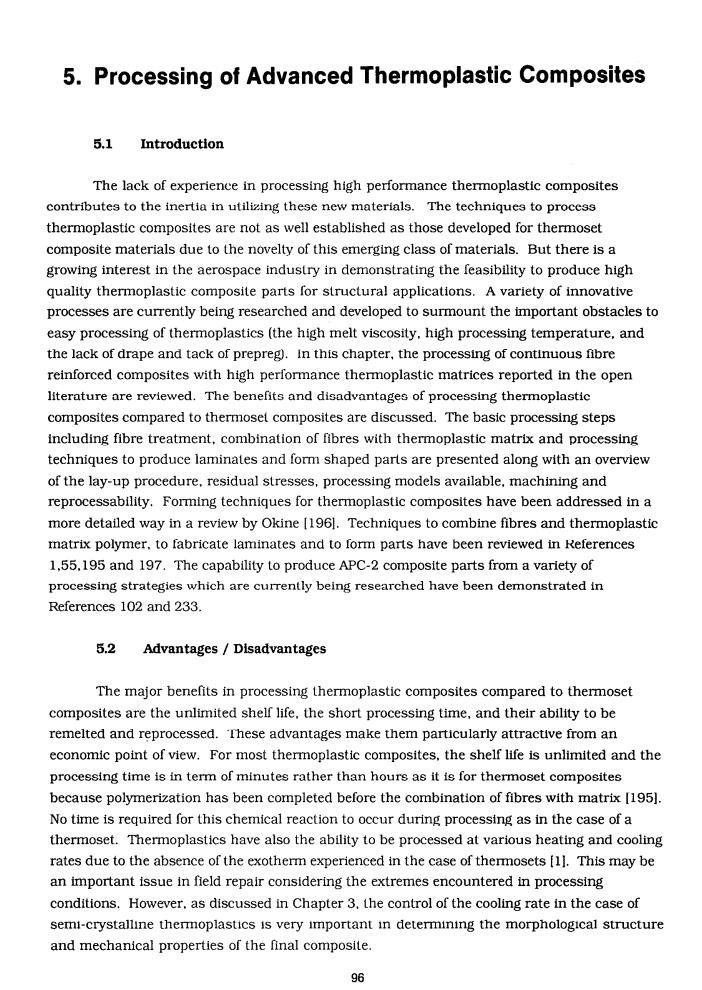正在加载图片...

5.Processing of Advanced Thermoplastic Composites 5.1 Introduction The lack of experience in processing high performance thermoplastic composites contributes to the inertia in utilizing these new materials.The techniques to process thermoplastic composites are not as well established as those developed for thermoset composite materials due to the novelty of this emerging class of materials.But there is a growing interest in the aerospace industry in demonstrating the feasibility to produce high quality thermoplastic composite parts for structural applications.A variety of innovative processes are currently being researched and developed to surmount the important obstacles to easy processing of thermoplastics (the high melt viscosity.high processing temperature,and the lack of drape and tack of prepreg).In this chapter,the processing of continuous fibre reinforced composites with high performance thermoplastic matrices reported in the open literature are reviewed.The benefits and disadvantages of processing thermoplastic composites compared to thermoset composites are discussed.The basic processing steps including fibre treatment,combination of fibres with thermoplastic matrix and processing techniques to produce laminates and form shaped parts are presented along with an overview of the lay-up procedure.residual stresses,processing models available,machining and reprocessability.Forming techniques for thermoplastic composites have been addressed in a more detailed way in a review by Okine [1961.Techniques to combine fibres and thermoplastic matrix polymer.to fabricate laminates and to form parts have been reviewed in References 1.55.195 and 197.The capability to produce APC-2 composite parts from a variety of processing strategies which are currently being researched have been demonstrated in References 102 and 233. 5.2 Advantages Disadvantages The major benefits in processing thermoplastic composites compared to thermoset composites are the unlimited shelf life.the short processing time,and their ability to be remelted and reprocessed.These advantages make them particularly attractive from an economic point of view.For most thermoplastic composites,the shelf life is unlimited and the processing time is in term of minutes rather than hours as it is for thermoset composites because polymerization has been completed before the combination of fibres with matrix [195]. No time is required for this chemical reaction to occur during processing as in the case of a thermoset.Thermoplastics have also the ability to be processed at various heating and cooling rates due to the absence of the exotherm experienced in the case of thermosets [1l.This may be an important issue in field repair considering the extremes encountered in processing conditions.However.as discussed in Chapter 3.the control of the cooling rate in the case of semi-crystalline thermoplastics is very important in determining the morphological structure and mechanical properties of the final composite. 965. Processing of Advanced Thermoplastic Composites 5.1 Introduction The lack of experience in processing high performance thermoplastic composites contributes to the inertia in utilizing these new materials. The techniques to process thermoplastic composites are not as well established as those developed for thermoset composite materials due to the novelty of this emerging class of materials. But there is a growing interest in the aerospace industry in demonstrating the feasibility to produce high quality thermoplastic composite parts for structural applications. A variety of innovative processes are currently being researched and developed to surmount the important obstacles to easy processing of thermoplastics (the high melt viscosity. high processing temperature, and the lack of drape and tack of prepreg). In this chapter, the processing of continuous fibre reinforced composites with high performance thermoplastic matrices reported in the open literature are reviewed. The benefits and disadvantages of processing thermoplastic composites compared to thermosel composites are discussed. The basic processing steps including fibre treatment, combination of fibres with thermoplastic matrix and processing techniques to produce laminates and fomr shaped parts are presented along with an overview of the lay-up procedure, residual stresses. processing models available, machining and reprocessability. Forming techniques for thermoplastic composites have been addressed in a more detailed way in a review by Okine [ 1961. Techniques to combine fibres and thermoplastic matrix polymer, to fabricate laminates and to form parts have been reviewed in References 1.55.195 and 197. The capability to produce ARC-2 composite parts from a variety of processing strategies which are currently being researched have been demonstrated in References 102 and 233. 5.2 Advantages / Disadvantages The major benefits in processing thermoplastic composites compared to thermoset composites are the unlimited shelf life, the short processing time, and their ability to be remelted and reprocessed. These advantages make them particularly attractive from an economic point of view. For most thermoplastic composites, the shelf life is unlimited and the processing time is in term of minutes rather than hours as it is for thermoset composites because polymerization has been completed before the combination of fibres with matrix [195]. No time is required for this chemical reaction to occur during processing as in the case of a thermoset. Thermoplastics have also the ability to be processed at various heating and cooling rates due to the absence of the exotherm experienced in the case of thermosets [l]. This may be an important issue in field repair considering the extremes encountered in processing conditions. However, as discussed in Chapter 3. the control of the cooling rate in the case of semi-crystalline thermoplastics is very important in determining the morphological structure and mechanical properties of the final composite. 96